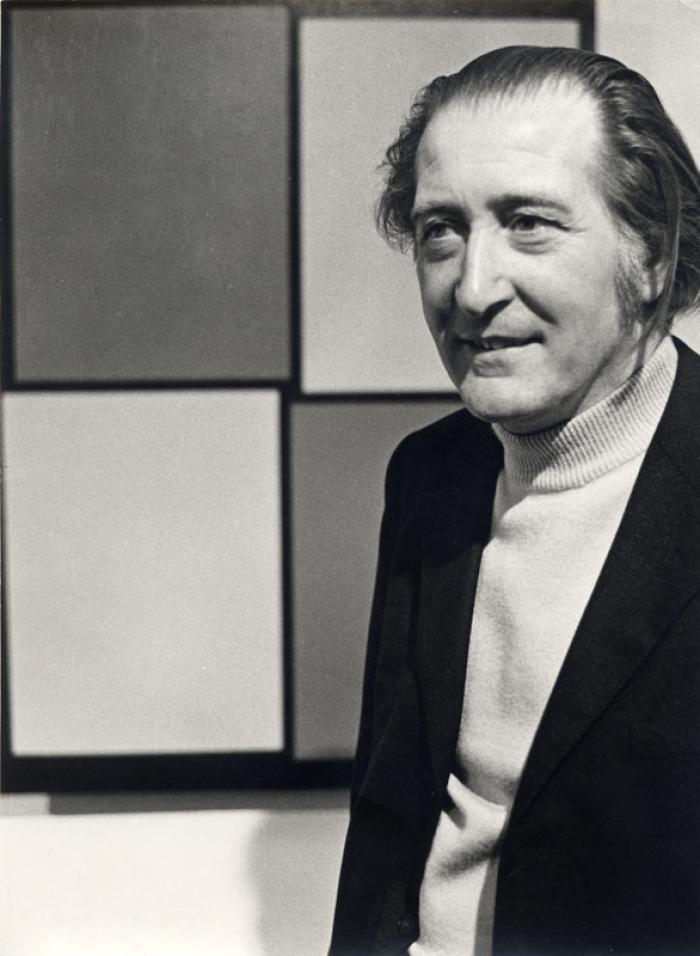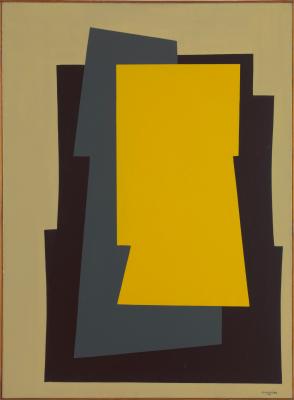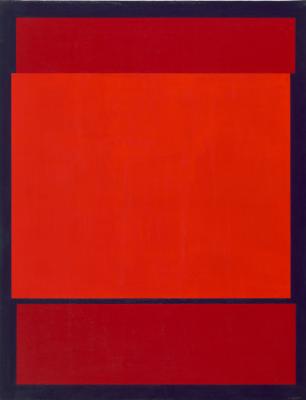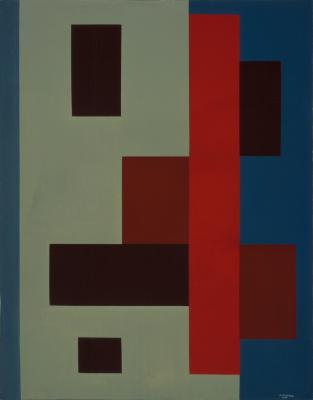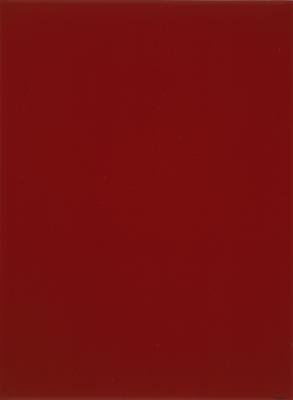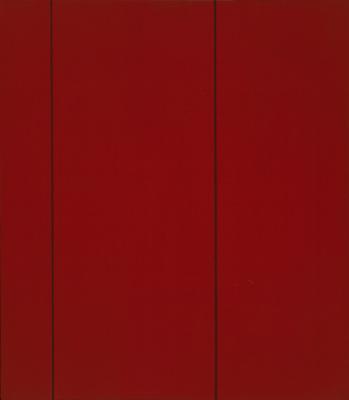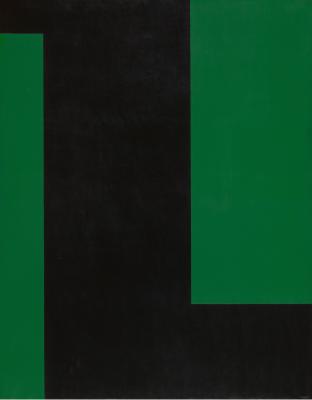From 1936 to 1942, Amédée Cortier enjoys his training at the Royal Academy of Fine Arts in Ghent. On the one hand, his oeuvre consists of paintings that he makes in various media (acrylic, oil, gouache, aquarelle, India ink or bistre, among others) on panel, paper or cardboard. On the other hand, he makes pen drawings, reliefs and models. Around 1950, influenced by the exhibition Le Cercle Artistique (Ghent, 1949), he applies himself to a short-lived geometric-abstract experiment, but decides after this to return to embrace his figurative visual language. He begins with painting rural scenes (1940), still lives and portraits of women (1950), and evolves towards a stark, simplified figurative language in schematic compositions. André Lothe (1885 - 1962) exerts an important influence on him with his Traité de la figure (1950) and Traité du paysage (1939). Around 1964 Cortier begins to paint resolute abstract and from 1966 - 1967 he favours colour over the relations between the forms. The transition to acrylic paint is to be understood in the same context. This medium helps him to heighten the intensity of his colours. His stark works are witness to a sense of natural law, but also leave room for intuition. Ultimately Cortier changes over to monochrome, by which he creates mutually coherent ensembles in the form of diptychs and triptychs. With his reliefs (1968), he evolves from the traditional painting to painting as object. Beginning in the 1970’s his work is completely dominated by colour, built up around a stark composition and a unity between colour and form. He gains public recognition with these works.
Cortier sees his own oeuvre confirmed in the work by the artist Ellsworth Kelly (1923 - 2015). Under the impulse of Peter Struycken (1939) he meets Kelly in 1976. As a member of Het Antenneke, his fascination grows for the Golden Ratio, an important compositional rule in his oeuvre. His friendship with Yves De Smet (1946 - 2004) is of crucial importance for his artistic career. He is not only a like-minded artist friend, but is also an important promoter and organiser of exhibitions dedicated to Cortier, such as Horizonnen & horizontalen (Horizons & horizontals) (1976). Cortier becomes a member of the Ghent group organised by De Smet called Plus-Groep, a collective of Ghent constructivists that are seeking the unity between form and colour. Via Plus-Kern - Centre for Constructive Design, established by De Smet and others in 1969, Cortier is actively promoted. This occurs through the medium of publications such as Plus-Nieuws, though also through participation in international exhibitions. In 1973 he is internationally recognised with the Sikken Prize.
4 October 1921
Amédée Cortier is born in Ghent
1940
Studies at the Royal Academy of Fine Arts in Ghent.
1955
He maintains contacts with the artist group Het Antenneke.
1958
First exhibition in the Ghent gallery Vyncke-Van Eyck.
1960
The artist shows his stark compositions from the years 1958-60 at a second solo exhibition in the Ghent gallery Vyncke-Van Eyck.
1962
Is selected for the Europa Prize by the City of Ostend with Hommage à Gust De Smet (1961), Epuration (1961) and Accent grave (before April 1962). The three works are selected by the jury for the exhibition in the Kursaal of Ostend.
September 1962
Cortier exhibits completely abstract canvases in Galerie Vyncke-Van Eyck.
1964
Exhibits in the gallery Au Cheval de Verre in Brussels. During this year he begins to convincingly paint abstract. Around March and April, four paintings by him are taken up in the exhibition Kunst van vandaag (Art of Today), in which lyrical and geometric abstract works are to be seen alongside contemporary figurative painting. His paintings hang there next to those of Gilbert Decock, Jo Delahaut, Jozef Peeters, Luc Peire, Victor Servranckx, Gilbert Swimberghe, Guy Vandenbranden and Dan Van Severen.
He exhibits, in addition to 37 other participating artists, at the exhibition Gekonstrueerde abstrakte kunst in the Brussels Galerie de la Madeleine. It is an homage to the art critic Jean Séaux.
His choice for the geometric abstract is confirmed in the autumn of 1964 in his exhibition in the Galerie Oranje in Ghent.
1965
He paints a number of compositions that can be viewed as triptychs.
1966
Cortier is taken up into the Plus-Groep, established in 1966 by Yves De Smet, Willy Plompen (1942) and Jan Van den Abbeel (1943). He participates in the exhibition Plus in the Hoger Sint-Lucasinstituut in Ghent, along with De Smet, Plompen, Van den Abbeel, Albert Rubens (1944), Gerard Geerinckx and René Heyvaert (1929 - 1984).
1966 - 1967
Cortier begins to work with acrylic paint in order to heighten the light intensity of the colour. In his work lies a greater emphasis on colour and less on the relations between the various forms.
Exhibits in Galerie Foncke in Ghent.
1968
Participates in the exhibition Speeltijd (Playtime) in Bruges, the exhibition Groupe Plus: Cortier, De Smet, Plompen, Van den Abbeel in Florence and the exhibition Constructive art België-Luxemburg in gallery Disque Rouge in Brussels.
Begins to create reliefs.
1969
Takes part in Art construit en Belgique (Art made in Belgium), organised by the Tournai art circle SIGMA 13 and in Kleur + Licht (Colour + Light). This is an international exhibition of contemporary constructive art in Galerie Waumans in Sint-Niklaas.
Thanks to a mention for the Prize for Painting of the city of Knokke, Cortier is selected for the accompanying exhibition in the Casino of the city.
He is awarded the bronze medal for the Europa Prize for painting (Ostend, 1969). His work is shown in the Kursaal.
Is selected for Forum van de Grafiek: Forumprijs 69 in Ghent.
A solo exhibition is organised in his honour in the city hall of Roeselare by the local Friends of Contemporary Art.
Participates in the exhibitions Plus-Kern bij Carlos Demeester.
At the end of the year, Cortier receives a solo exhibition in Plus-Kern, at which he shows canvases, recent reliefs and the model Kleuromgeving. This exposition places him within a professional avant-garde context. The work there is to be seen announces his evolution in the 1970’s.
1971
Definitively replaces oil paint with acrylic.
Receives a solo exhibition in the Groninger Museum voor Stad en Lande, in collaboration with Plus-Kern.
Takes part in the group exhibition Hedendaagse Konstruktieve Kunst in België in ‘s-Hertogenbosch and Leiden.
His works are exhibited once again by Plus-Kern.
1972-73
The exhibition Aquarel en Gouache is set up for the Ministry for National Education and Netherlandish Culture in various locations in Belgium and is in 1972 - 1973 to be seen during a tour through Brazil.
Cortier’s work is exhibited by the Centrum voor Kunst en Kultuur in Ghent in collaboration with Plus-Kern and the Provinciale Dienst voor Kunstambachten.
1976
His work is exhibited in Horizonnen & horizontalen by Yves De Smet.
Amédée Cortier dies on 11 February 1976 in Ghent.
Sergio Servellón
CC-BY-NC (Creative Commons 4.0)
